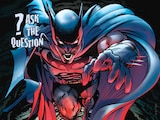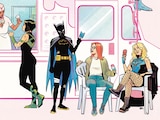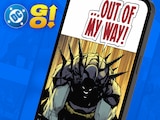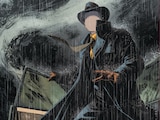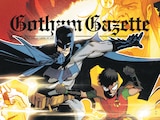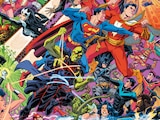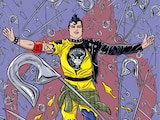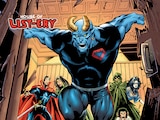The murder of Thomas and Martha Wayne is probably one of the most replayed scenes in comic books. It’s an important moment, since it led to Bruce Wayne’s creation of Batman. But how did that moment evolve? We all know about their stroll through Crime Alley after seeing The Mark of Zorro, and the shattered pearl necklace. But did you know that it wasn’t always an alley? Or that in some versions, Martha wasn’t even shot? Everything from Bruce’s age when his parents’ deaths occurred to the movie they were seeing just prior to it has evolved over the years. Let’s explore the evolution of Batman’s tragic origin.

1939 – Detective Comics #33
Batman’s origin is such a huge part of his mythology that it’s hard to believe that we didn’t get it until his seventh appearance. Here, the origin story is two pages long, with five panels devoted to the Wayne murders. Although this moment has been retold many times, most of what we see in those five panels has remained.
For example, we’re told that the Wayne family is on their way home from a movie. Their mugger asks for Mrs. Wayne’s necklace (she wasn’t called Martha yet), causing Thomas to fight back. Both are gunned down before Bruce’s eyes.
It’s interesting to note what hadn’t been established yet. The mugger and Mrs. Wayne are both unnamed, but that’s not the case with Thomas. We don’t know what movie the Waynes were seeing, and Crime Alley isn’t named. In fact, the artwork makes it appear that the Waynes were shot on a city sidewalk. The broken pearl imagery is also missing.
Still, this is where Batman’s origin was born, making it one of the most important comic book sequences of all time.

1948 – Batman #47
Believe it or not, this is the first time Batman’s origin story was retold! These days we might not be able to escape the ceremonial gunning down of the Waynes, but that original origin story was the only one we got for nearly ten years. (It’s worth noting, that original story got a reprint in 1940’s Batman #1).
In Batman #47, Martha Wayne was named for the first time, but the circumstances of her death were changed. The editors at DC thought that having a woman gunned down in front of her child was too severe. So instead, Martha died on the spot when her “weak heart stopped from sudden shock” after seeing her husband murdered. (Is that less severe? Sure doesn’t feel like it.)
Notably, the murderer of the Waynes was identified as Joe Chill for the first time. Once again, the artwork depicts the murder happening on a city sidewalk. In fact, you can even see a car driving by in one panel. Would it have killed them to pull over and help the Waynes?

1956 – Detective Comics #235
Batman learns that the murder of his parents wasn’t a random robbery. A mobster named Lew Moxon had hired Joe Chill to assassinate the couple. This is an element of the origin that has persisted off and on over the years depending on the continuity. In some versions, the Waynes are deliberately targeted (Fox’s Gotham is a good example), while other versions continue to portray it as a random robbery.

1959 – Detective Comics #265
This time around, the Wayne murders occur during the day. There is no mention of a movie theater, and the narration says the Waynes are enjoying a stroll. Joe Chill seems to shoot the Waynes out of fear and panic when Thomas resists his stickup attempt. For the first time since 1939, Martha Wayne is shot, ignoring the previous heart attack retcon.

1966 – Batman, “Hi Diddle Riddler”
Bruce Wayne’s parents are only mentioned once in the 1966 Adam West Batman series. In the first episode, Bruce Wayne tells a colleague that his parents were “murdered by dastardly criminals.” Interestingly, this implies that more than one gunman was involved.

1968 – Batman #200
We get another flashback to the Wayne murders. This retelling goes back to the “Martha died of a heart attack” portrayal.

1969 – Batman #208
The Wayne murders are seen in another flashback. Once again, Martha dies of a heart attack. We learn that Joe Chill’s mother Mrs. Chilton helped raise Bruce as penance for her son’s actions. Bruce is unaware of her connection to his parents’ murderer.

1971 – Batman #232
Bruce flashes back to the murder of his parents. According to him, the shooting occurred in the summer. Martha Wayne is shot in this version, and the heart attack angle is dropped in all subsequent retellings.

1972 – Superboy #182
This comic is set in the aftermath of the Wayne murders, which according to the story, take place on November 25th. In this version, Bruce Wayne is a high school student when he becomes an orphan. Bruce believes that the Zodiac Killer gunned down his parents (yes, really), until Superboy convinces him that it was just a random robbery.

1976 – Detective Comics #457
We learn the name of the street where the Waynes lost their life—Crime Alley. Detective Comics #457 establishes that Crime Alley was once a prosperous neighborhood called Park Row, but over the years it became a cesspool of crime, earning it the infamous nickname. This issue also establishes a key piece of Batman lore: after the death of his parents, Bruce was found and comforted by a kindly old woman named Leslie Tompkins. At the time of this story, Leslie was not yet a doctor, and she was unaware of Bruce’s double life.
Detective Comics #457 also established Bruce’s tradition of making an annual pilgrimage to Crime Alley on the anniversary of his parents’ death. The cover depicts Bruce kneeling next to his parents’ bodies under a streetlight. This iconic imagery would be repeated many times, including in Batman: Year One.

1981 – Detective Comics #500
This milestone issue establishes that Bruce Wayne was eight years old when his parents were shot. Prior to this, no specific age was given. Although subsequent comics would sometimes give alternate ages, eight has largely become the accepted age in the Batman canon.
We still aren’t told what movie the Wayne family saw, but Thomas does compliment Marlon Brando’s performance. This comic was published in 1981, and we’re told the shooting happened twenty years ago. The only Marlon Brando movie released in 1961 was One-Eyed Jacks, so unless this was a re-release, that was the film they saw.

1984 – Batman Special #1
The special opens with a flashback to the Wayne murders. According to the narration, the death of the Waynes occurred on June 26th.

1984 – Batman and the Outsiders #13
In order to snap Batman out of a trance, the Outsiders disguise themselves as Bruce’s parents and Joe Chill and reenact the Wayne murders. Yes, this is a very dubious plan. However, it does reveal that on the night of the shooting, the Waynes took Bruce to a double feature. So, the question isn’t what movie did Bruce see, but rather which MOVIES. At least, for now.

1985 – Super Friends, “The Fear”
This was the first time the death of the Waynes was depicted in any form of Batman media outside of the comics. After being infected with Scarecrow’s fear gas, Batman flashes back to the murder of his parents. It doesn’t help that Scarecrow makes his escape through Crime Alley, forcing Batman to stand in the spot where his life fell apart.
Super Friends was an animated show for children, so the scene was heavily censored. We never see Joe Chill’s gun during the murder, and the gunshot sounds are drowned out by the thunderstorm in the background.
For the first time, we learn definitively what movie the Waynes were watching—Robin Hood. And speaking of Robins, this episode implies that Dick Grayson was unaware of the Wayne murders (!!). The flashback is also the first time Alfred is depicted as Bruce’s childhood guardian following his parents’ murder, something the comics would adapt in the post-Crisis era.
While early depictions of the Wayne murders took place on a sidewalk, some versions placed the Waynes in an alley. Naming the site of their demise Crime Alley only added to the confusion, which has caused people to ask why the affluent Waynes would walk home from a movie through an alley. This show gave an explanation—it was raining and Thomas Wayne wanted to take a shortcut through the alley.

1986 – Batman: The Dark Knight Returns #1
Frank Miller’s classic storyline not only reinvented Batman, it also reinvented Batman’s origin. In this take, the Waynes go to see The Mark of Zorro. This is the film that would be used in most versions of Batman’s origin going forward. The Dark Knight Returns is also the first retelling to show Martha Wayne’s pearl necklace shattering, with the individual pearls falling to the floor. This tragic imagery would become an important part of the origin story going forward.

1989 – Batman
Tim Burton’s 1989 film is the first time the Wayne murders were depicted in live action. Shortly before the shooting, the Waynes are seen exiting the Monarch Theater, which is named for the first time. Famously, the movie made some controversial changes to the origin, presenting Jack Napier (the future Joker) as the Waynes’ killer. It’s also the first version of the origin where the killer had an accomplice. According to producer Michael Uslan, the other mugger was meant to be Joe Chill.

1994 – Detective Comics #678
Bruce Wayne travels back in time (thanks to the Zero Hour crossover event) to the night of his parent’s murder. He learns that Joe Chill had been laid up in bed due to heavy drug use, making it impossible for him to be their killer. This was driven by the creative decision to have the Waynes’ killer be an anonymous gunman rather than Chill, taking away whatever closure identifying his parents’ murderer gave to Bruce. This idea was abandoned later, with future versions of the origin going back to Chill as the mugger.

2004 – The Batman, “Traction”
This episode flashes back to the night of the Wayne murders. After the death of his parents, Bruce is tended to by Jim Gordon, during the early days of his police career. The film Batman Begins and the television series Gotham built on this idea, presenting Jim Gordon as one of the first responders to the Wayne shooting.

2005 – Batman Begins
The 2005 Christopher Nolan film presented a new take on Batman’s origin. Instead of seeing a movie, the Waynes went to see an opera, specifically Mefistofele. The bat costumes in the opera frightened Bruce, and he asked his parents if they could leave early. This added a new wrinkle to the origin—Bruce felt guilty because if he wasn’t afraid, his parents wouldn’t have left the opera and gotten shot.

2014 – Gotham
The Fox television drama presented its own version of the Wayne murders in its pilot. On Gotham, the killer wore a mask, giving the show a mystery that would span multiple seasons. The series also added Selina Kyle as a witness to the crime, who was watching unseen from a nearby rooftop.
As the series progressed, it was revealed that Patrick Malone had shot the Waynes, after being hired by Dr. Hugo Strange, who had been taking orders from the Court of Owls, under the direction of the League of Assassins and Ra’s al Ghul. It got crazy complicated.

2018 – Teen Titans GO! to the Movies
In this 2018 animated movie, the Teen Titans go back in time to stop various superhero origins. (They wanted their own superhero movie and figured if they got rid of all the other heroes, then Hollywood would be forced to give them one.) Traveling back to the night of the Wayne murders, the Titans warn the family about the dangers of Crime Alley.
“That is Crime Alley, you dumb dumbs,” Cyborg says. “May I suggest you take a shortcut through Happy Lane instead,” Starfire suggests. The Waynes take the advice, preventing their murders and the creation of Batman.
By the way, this time around the Waynes are seeing a double feature—The Mark of Zorro and Beware the Grey Ghost. Perhaps this is what Batman and the Outsiders #13 was talking about?
After realizing the world needs heroes, the Titans go back in time to undo their original interference. Raven places a beautiful pearl necklace around Martha’s neck, and Robin pushes the couple into Crime Alley. We hear their terrified screams as Robin smiles and Bruce Wayne looks on in horror.
Seriously, people, if you haven’t seen this movie, you really need to.

2019 – Joker
The Joaquin Phoenix-starring film took a different approach to the Wayne murders. Riots erupt in the streets of Gotham after a segment of the population becomes radicalized by Arthur Fleck’s message of anarchy. The Waynes are seen exiting a theater amidst the chaos (this time around, they saw Zorro, The Gay Blade).
The family attempts to escape the carnage by walking through a seemingly deserted alley, but a radicalized man in a clown mask spots them and opens fire. It’s interesting to note that robbery wasn’t the motivating factor this time and that like in 1989’s Batman, the Joker is responsible for Batman’s birth (albeit more indirectly).

2022 – Harley Quinn, “Batman Begins Forever”
Using Doctor Psycho’s powers, Harley enters Bruce Wayne’s mind during this surprisingly sweet and very surreal third season episode. During the trip through his memories, we learn that Bruce is in a perpetual loop of seeing his parents murdered over and over again. In fact, during this episode, the Waynes are murdered twenty times! That’s more than double the number of times we saw Batman’s origin depicted in the comics over his first thirty years.
“I cannot believe we are being subjected to this multiple times,” Ivy said. Guess what, Ivy? I don’t think we’ll be stopping anytime soon.
It might seem like we’re seeing the same moment replayed over and over again, but dig a little deeper and there’s a surprising amount of variation in all these origin retellings. Like the Dark Knight himself, Batman’s origin has evolved and grown, while staying true to its core. It’s a painful, violent moment, but it gave birth to one of pop culture’s most beloved heroes. It also serves as a constant reminder that through great tragedy could come great strength—a thought that’s nearly as inspiring as the Dark Knight itself, seeing as how we all have our hardships we need to face.
Still, as we celebrate Batman Day this weekend, it might be fitting to take a moment to also celebrate his parents. They tragically gave their lives so that Gotham’s beloved bat could fly. Their dark night gave us the world’s Dark Knight. It’s a sad legacy, but an undeniably great one.
Batman Day is Saturday, September 16th! Be sure to visit our Batman Day hub page for videos, news and activities to help you celebrate the Dark Knight’s big day.
Joshua Lapin-Bertone writes about TV, movies and comics for DC.com, is a regular contributor to the Couch Club and writes our monthly Batman column, "Gotham Gazette." Follow him on Twitter at @TBUJosh.
NOTE: The views and opinions expressed in this feature are solely those of Joshua Lapin-Bertone and do not necessarily reflect those of DC Entertainment or Warner Bros., nor should they be read as confirmation or denial of future DC plans.



